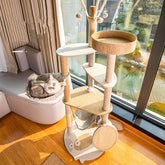Understanding Cat Panting: When to Worry and What to Do
Table of Contents
- Key Highlights:
- Introduction
- When Is Panting Normal?
- When Panting Signals a Problem
- Diagnosis and Treatment
- What Should Cat Owners Do?
Key Highlights:
- Unlike dogs, panting in cats can indicate health issues and should not be overlooked.
- Common benign reasons for panting include exercise or stress, while persistent panting may signal serious conditions such as asthma or heart failure.
- Timely veterinary intervention is crucial for diagnosing and treating underlying health problems.
Introduction
Cats are known for their graceful movements and calm demeanor, qualities that often lead us to believe they are immune to stressors that typically affect other pets. However, if you’ve ever noticed your feline friend panting with their mouth ajar, alarm bells should ring. Unlike canines, cats rarely exhibit this behavior. Instead, panting can be a sign that something is wrong. In this article, we will explore the various causes of panting in cats, how to distinguish between harmless and concerning signs, and what to do if your cat shows this symptom.
When Is Panting Normal?
Understanding normal versus abnormal behavior in cats can be challenging for many pet owners. Panting may occur briefly under certain conditions, which include:
Exercise and Play
Similar to humans, cats may pant after vigorous exercise. Kittens and younger cats are particularly prone to this behavior as they engage in playful activities like sprinting or climbing. A moment of elevated heart rate can lead to elevated respiratory rates, during which panting may occur.
Temperature Regulation
Cats may also pant as a means of thermoregulation in hot weather. Though not their primary method of cooling down (which involves seeking cooler surfaces or laying in the shade), some cats may resort to panting when temperatures peak. Just as we sweat, panting serves as a mechanism to prevent overheating.
Stress or Excitement
Certain events may trigger excitement or stress, such as loud noises or unexpected visitors. During these instances, cats may pant as part of their fight-or-flight response, which heightens their breathing rate but is usually short-lived.
What to Monitor
Most instances of panting due to physical exertion or environmental factors are transitory, and normal breathing typically resumes once your cat relaxes. Observe your cat after such moments and ensure they have access to fresh water, a cool resting area, and plenty of calm.
When Panting Signals a Problem
While not all panting is cause for concern, certain signs indicate the need for immediate veterinary attention. If your cat displays persistent panting alongside other symptoms, it may suggest serious health conditions.
Key Symptoms of Concern
When assessing your cat's health, consider these accompanying signs:
- Pale Gums: Healthy gums are typically pink. If you find them pale, it may indicate poor circulation or oxygenation.
- Loss of Appetite: Disinterest in food or sudden changes in eating habits can signal distress.
- Lethargy: Excessive tiredness or lack of energy is concerning and warrants further investigation.
Potential Serious Conditions
Persistent panting may be a symptom of various health issues, including:
- Feline Asthma: Inflammation in the airways can cause wheezing and difficulty breathing. This condition may require long-term management but can often be effectively treated if caught early.
- Respiratory Infections: Viral or bacterial infections can lead to inflammation of the lungs, making it difficult for cats to breathe easily.
- Congestive Heart Failure: This serious condition can occur due to fluid buildup, which hampers proper oxygenation.
- Heatstroke: Excessively high body temperatures can prompt rapid breathing. In extreme cases, this may lead to serious complications like organ failure.
- Inhaled Objects: If a foreign object obstructs the airways, it can lead to immediate distress and requires urgent care.
Older cats, particularly those with pre-existing conditions, may be at a heightened risk for these serious health issues. Cat owners should closely monitor their pets for any unexpected changes in behavior or health and consult a veterinarian without delay.
Diagnosis and Treatment
Upon visiting a veterinarian, several diagnostic measures may be employed to determine the underlying cause of panting. A thorough examination is crucial to ensure your cat receives appropriate treatment.
Diagnostic Procedures
- Chest X-rays: These can help visualize any abnormalities in the lungs, heart, or surrounding structures.
- Blood Tests: Blood work can give insights into overall health, rule out infections, and measure oxygen levels.
- Oxygen Saturation Checks: Evaluating how much oxygen is circulating in your cat’s blood can indicate respiratory distress.
Treatment Options
Treatment will depend on the diagnosed condition. Some common methods may include:
- Oxygen Therapy: Administering pure oxygen can help cats with severe respiratory issues breathe more easily.
- Intravenous Fluids: Hydration and electrolyte balance are critical, especially in cases of heatstroke or significant illness.
- Medications: Antiinflammatories, bronchodilators, or antibiotics might be necessary based on the condition being treated.
Timely diagnosis and intervention are vital since conditions such as feline asthma can be managed effectively when addressed early. In contrast, issues like congestive heart failure or severe infections may require ongoing management tailored to the individual cat's needs.
What Should Cat Owners Do?
If you observe panting in your cat, it’s essential to remain calm while taking prompt actions to investigate the situation further.
Immediate Steps
- Assess the Environment: Check if there are immediate stressors such as loud noises, unfamiliar animals, or extreme temperatures.
- Monitor Symptoms: Observe your cat for any additional symptoms of distress, such as coughing or unusual posturing.
- Keep Comfortable: Provide a calm and quiet environment for relaxation. Make sure water is available, and if it’s hot, try to keep your cat cool.
- Contact Your Veterinarian: If panting persists for more than a short duration, especially if accompanied by other symptoms, contact your veterinarian immediately.
Emergency Situations
In cases of severe respiratory distress or if any of the concerning signs present themselves (like pale gums, loss of coordination, or unresponsiveness), seek an emergency veterinary service without delay. Cats can deteriorate rapidly, and timely intervention can save their lives.
FAQ
1. Are there any benign reasons for cat panting? Yes, brief panting can occur after strenuous exercise, during stress, or in hot weather when the cat attempts to cool itself. Most often, normal breathing will resume soon after the stressful or exciting event.
2. How can I tell if my cat's panting is serious? If panting is persistent, occurs while at rest, or is accompanied by other symptoms such as lethargy, reduced appetite, or changes in gum color, you should seek veterinary advice promptly.
3. What steps can I take to help my cat breathe easier? Ensure your cat has access to fresh water, a cool environment, and avoid any stressful situations. Monitoring their symptoms will help determine if further action is needed.
4. What should I do if my cat is panting due to heat? If you suspect heat-related panting, immediately move your cat to a cooler area, provide water, and use a fan or air conditioning to lower the temperature. Do not apply ice directly to your cat; instead, use lukewarm water to aid cooling.
5. When is it appropriate to call the vet? If you are ever in doubt, it is always wise to err on the side of caution and consult your veterinarian, especially if your cat displays persistent panting with other troubling symptoms.
Understanding panting in cats elevates the owner’s ability to care for their pets proactively. While it is part of a broader behavioral context, knowing when to seek help can make all the difference in ensuring health and well-being.





